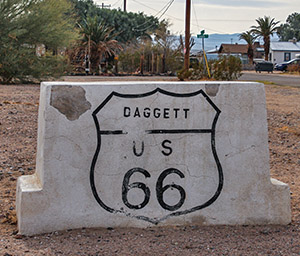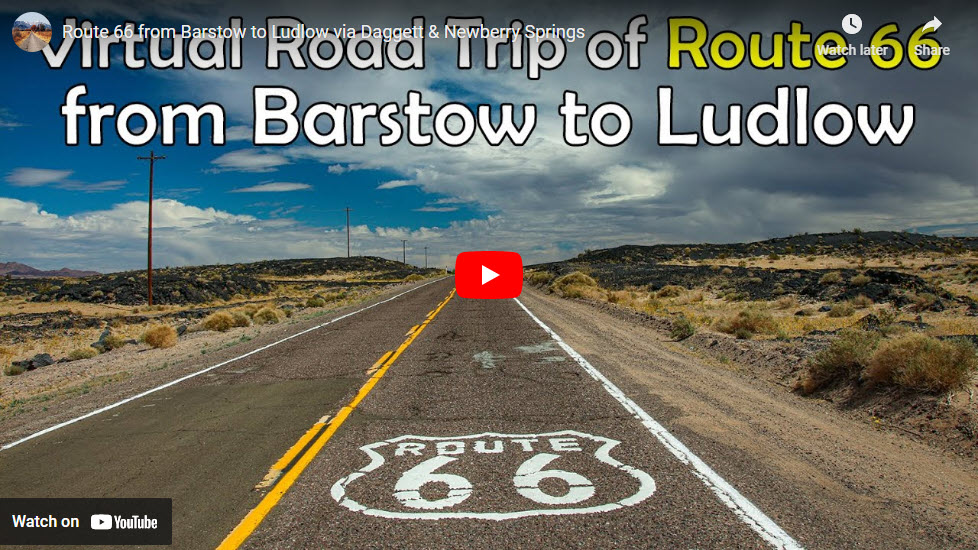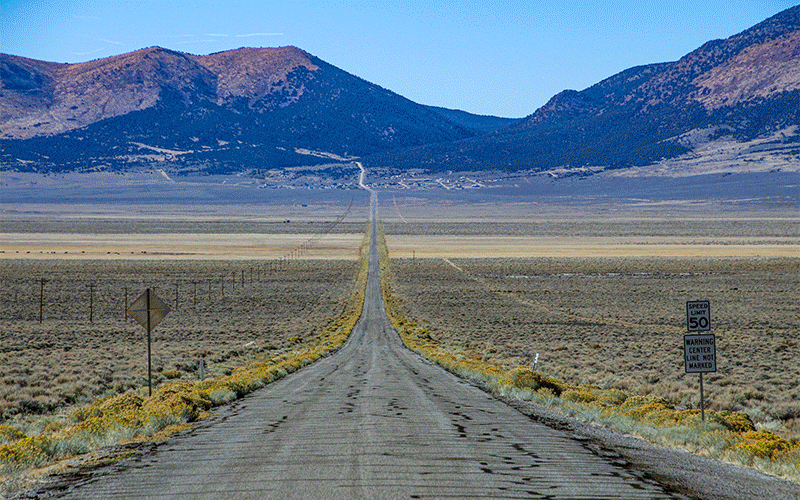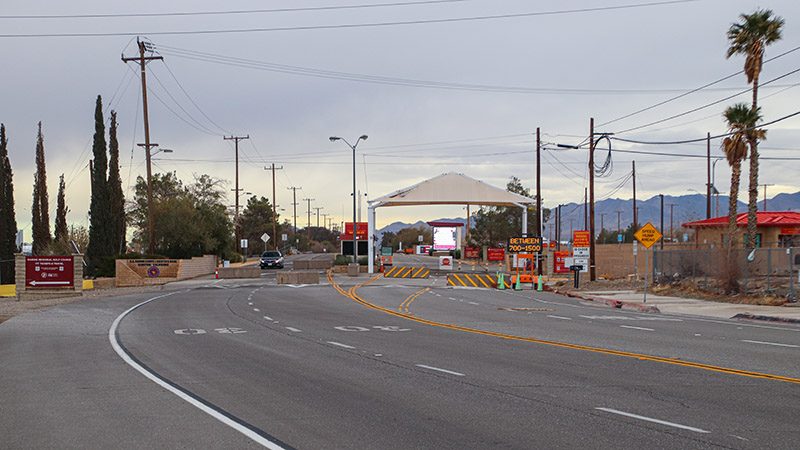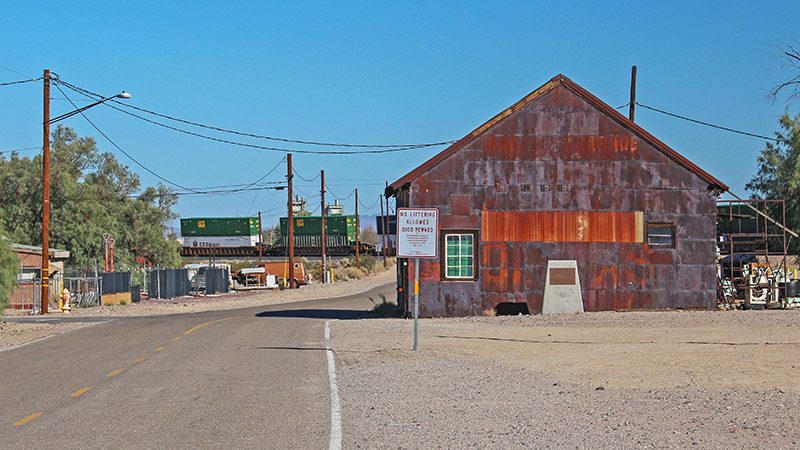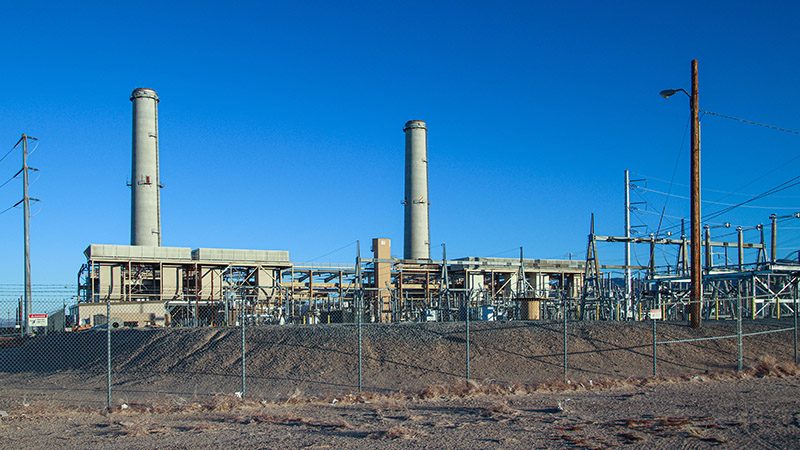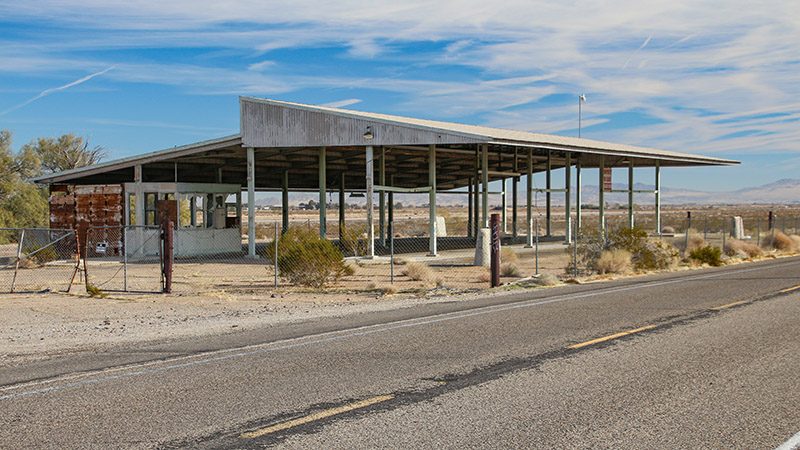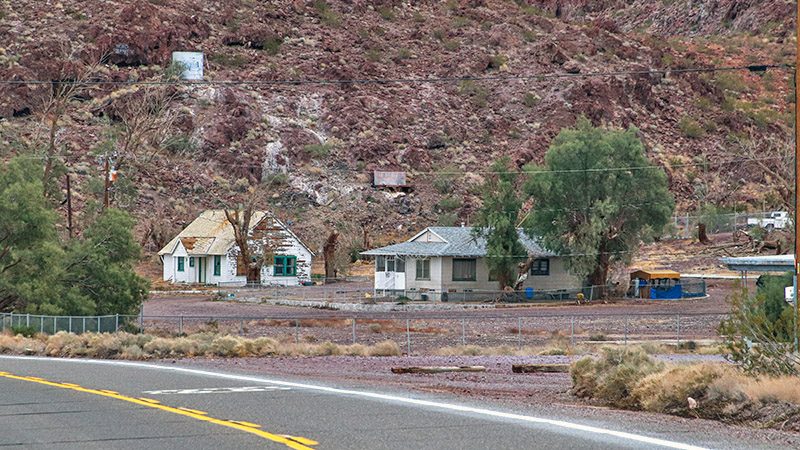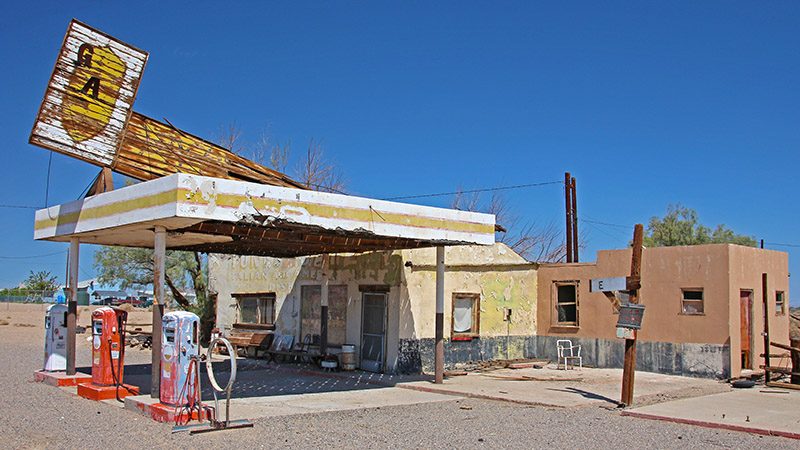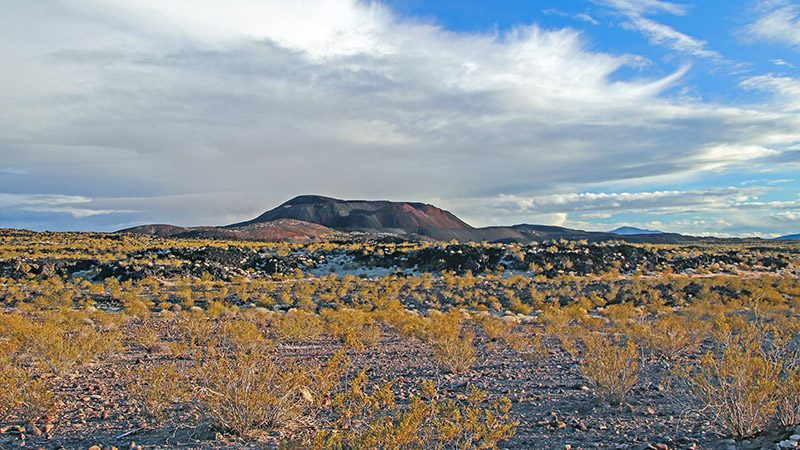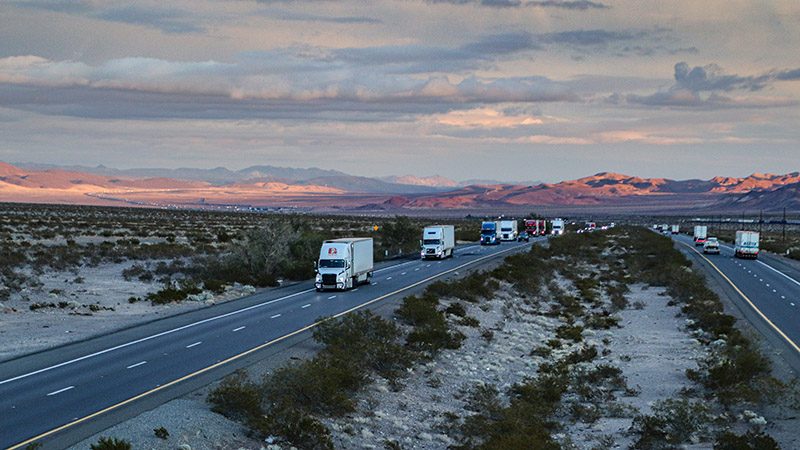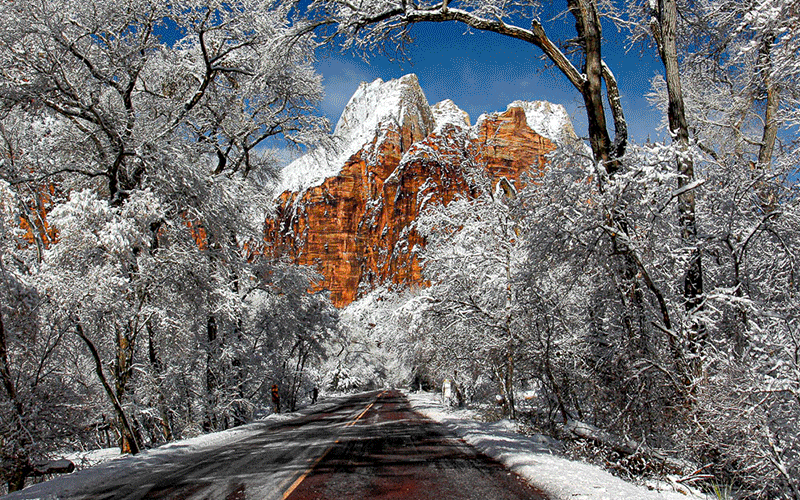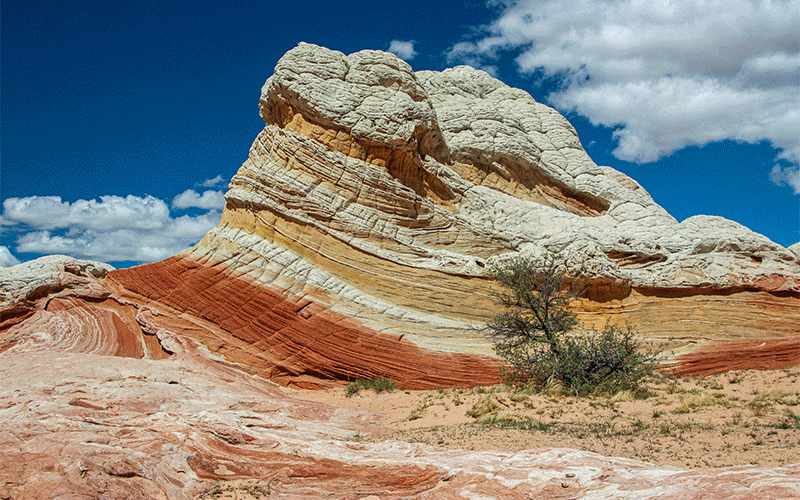Route 66 from Barstow to Ludlow
The most remote and barren stretch of Route 66 passes through California’s Mojave Desert between Barstow and the Colorado River, and the touring route described here covers the eastern half of it, between the towns of Barstow and Ludlow, and passing through the historic towns of Daggett and Newberry Springs. Driving this very remote part of the Mother Road back in the 1930’s made people nervous, and rightfully so. There was little traffic and, if their vehicle broke down, which they often did in those days, it was a long way to get help.
Length
Attractions
- Classic Americana
- Historic old buildings
- Route 66 attractions
- Old experimental power plants
- Large desert vistas
Difficulty
- Roads are all paved
- Rough pavement on eastern half
Elevation Gain
The Tour
Our tour starts on the east side of Barstow, where our previous tour of Main Street through downtown Barstow, ends. If you’ve missed that, see Driving Route 66 thru Downtown Barstow. This tour ends in the remote desert outpost of Ludlow.
Along the way, this tour visits these interesting towns and sites:
- Marine Corps Logistics Base Barstow with its connection to the Tournament of Roses Parade
- Elephant Mountain
- Daggett
- Cool Water Ranch & power plants
- Barstow-Daggett Airport
- Newberry Mountain
- Newberry Springs
- Pisgah Crater
This tour can be taken in either direction; from Barstow to Ludlow or Ludlow to Barstow. If you start in Ludlow, simply follow the tour itinerary in reverse.
Barstow
Begin your tour by driving to the east-end of Main Street in Barstow, where it passes underneath Interstate 40. You can also take the I-40 freeway and take exit #1. Reset your trip meter here.
There isn’t much to see along the 1.5 mile (2.4 km) stretch of Route 66 from exit #1 to the Marine Corps base. There used to be an old hotel and bar, but it was razed around 2010. If you’re not a serious or diehard Route 66 traveler, you can jump on I-40 and exit at Nebo Street (exit #5), which also bypasses the Marine Corps base.
Marine Corps Logistics Base Barstow
If you took Route 66 from exit #1, you’ll pass underneath I-40 again and in a short distance be stopped by the base’s main entrance. Just before the entrance stands an old gas station and hotel that was originally a Motel 6.
The alignment of Route 66 used to go right through the middle of this military installation. Until I-40 was built, Route 66 travelers drove right through the base as if it were another town along the road. Unfortunately, after the events of September 11, 2001, for security concerns, the public can no longer drive on this portion of Route 66 through the base.
The base is used as a supply depot and maintenance facility for the Marine Corps. It was originally established in 1942 to support the Pacific theater in World War 2. During this time, unneeded material, mainly wood for crates, were thrown away but picked up by locals to build many of the old buildings along Route 66. The base itself, has since grown to support the on-going needs of the Marines.
A satellite facility of the base was built later and called the Marine Corps Logistics Base Yermo Annex. It can be seen along this tour just north of our visit through Daggett. Here is where the Marines store a lot of their rolling stock. Trains can regularly be seen delivering or picking up the rolling stock, such as tanks, assault vehicles and JLTVs (Joint Light Tactical Vehicle).
An interesting side note about this facility, it is the home of a mounted color guard. Traditionally, this elite team of equestrians lead and kick off the beginning of the Tournament of Roses Parade on Pasadena’s Colorado Blvd, which ironically is also, Route 66.
To continue the tour, jump on I-40 eastbound at exit #2, drive two miles, then exit at Nebo Street (exit #5).
Passing by Elephant Mountain
After exiting Nebo Street, you’ll be connected back to the original alignment of Route 66 as it exits out of the east side of the Marine Base. Just like our tours of Route 66 from Victorville to Barstow, the old alignment is right next to the Santa Fe railroad trips, which are now owned by the Burlington Northern and Santa Fe Railway. These are the same railroad tracks that Route 66 roughly follows between Chicago and Los Angeles. There are many many “at grade” crossings of these same tracks and Route 66 along its entire length.
Between here and Daggett, you’ll experience the whoop-de-doos of driving through many dips in the road. These dips are caused by many drainage channels that run across the desert floor. These same types of channels are found all over the desert and cross Route 66 all the way into Arizona. When the roadbed was first built in the 1920s here (between Barstow and Daggett), it was simply built through these channels, causing the dips we’re experiencing now.
As we travel further east on Route 66, past Daggett, we’ll see that the road still crosses the many channels or ditches but now uses bridges instead. These were built in the 1920s and 30s, after it was determined that the road had too many dips for vehicles to drive through. By the ‘20s and ‘30s, vehicles by then were traveling faster than the normal 20-30 mph (32-48 kph) in previous years, causing newer vehicles needing to slow down for the dips.
In fact, and this might be hard to believe, Route 66 crosses more bridges between Daggett and the Arizona border than all the other bridges on the entire historic alignment of Route 66, from Chicago to Santa Monica. We’ll cover more on this topic on our next tour that continues east from Ludlow and into Needles.
Along this stretch of road, you’ll see a mountain come into view on the left. This is Elephant Mountain. It’s just across the sandy bed of the Mojave River from Route 66. Elephant Mountain saw several mining ventures that began the development of this area, mainly the town of Daggett, in the 1880s.
Elephant Mountain is also a significant archaeological site where debris, such as mill stones, pestles and mortars that were used by Native Americans, have been found here. There are also a few petroglyphs in a rock outcropping on the southern edge, as well as on an outcropping not far from Daggett-Yermo Road on the mountain’s east side.
Daggett
At about 7 miles (11 km) from I-40’s exit #1 (where we reset our trip meter), we reach Daggett. Although this looks like a forgotten and sleepy desert town, it actually has a lot of interesting history behind it and some of it is still standing around for you to go see.
Daggett had a lot going for itself back in the late 1800s. A lot of desert and Route 66 history occurred in Daggett; probably more than in any other town along Route 66’s path through the Mojave Desert.
The townsite was first established because of small mines in Elephant Mountain mentioned earlier. The mining boom of both silver and borax in the nearby Calico Mountains, just 6 miles to the north, brought a lot more people into the area. In 1882, the railroad arrived, and Daggett was the closest point to the silver town of Calico. Ore was hauled by wagon to Calico and, from there, hauled by train for smelting.
In the 1890s, the Calico Mountains also had a large borax mining operation. Ore was hauled down by the famous 20 mule teams to a facility in Daggett, where it was processed and shipped away via rail.
Daggett was also an outfitting and jumping off point for many mining outposts hundreds of miles to the north, such as Death Valley. Many prospectors and miners took the train to Daggett, then ventured on by horse to various points throughout the Mojave Desert.
When the National Old Trails Road was being established in 1912, that would later become the path of Route 66 through California (the road alignment we’re touring on), an enterprising blacksmith owner got a contract to create the road grade from Barstow to the Arizona border.
Just before reaching the stop sign, you’ll see this curious looking “Ski lodge” on the right. This was built in the early 1920s and was a standard design in those days used for California Welcome Centers. It was also standard to have an inspection station built nearby and there was one directly across the street from the Ski Lodge. Now it is a vacant lot.
This inspection station is a big piece of Route 66 history, because it is the inspection station that actually appeared in the classic movie, the Grapes of Wrath, the movie that gave Route 66 that classic name, the Mother Road. In the movie, here’s where Tom Joad, played by Henry Fonda, was almost turned back. The real history is that this inspection station actually did turn back migrant workers in the Great Depression who were trying to escape the Dust Bowl of Oklahoma and the Great Plains.
When you arrive at the stop sign in Daggett, consider taking a detour to explore a little bit of this nicely preserved town with so much history. Do this, by turning left at the stop sign, crossing the railroad tracks, then turning right onto Santa Fe Street (the street directly across the tracks).
Our first set of buildings to look at are the Desert Market and the Stone Hotel. The Desert Market is still serving customers today, just in case you want to go in and grab a snack. If you do, you’ll see a lot of historic pictures of Daggett. It’s almost like a museum.
The remains of the Stone Hotel date back to the 1890s. Here, people like Death Valley Scotty, grubstaked his many treks into the remote regions of his namesake (Death Valley) to look for that elusive ore (gold). Prospectors from all over got to Daggett by train, stayed one or more nights in town to gather their provisions, then ventured off for months into the vast Mojave Desert to the north.
Turn north onto the road next to the Desert Market, named Mill Street, to find the Daggett Historical Museum. If you find this little gem open, go inside and enjoy all the old photographs and artifacts that are well-preserved here.
Continue the tour down Route 66 by returning to the railroad crossing you crossed earlier, then turn left. Reset your trip meter when you turn left. On the way out of town, you’ll see more old buildings and the Daggett Pioneer Cemetery.
More…
Pictures
Below are some pictures of what you will see along the way.
Cool Water Area & Inspection Station
On the north side of the tracks are a few historical ranches and the remains of a few experimental power plants, one of which is still generating electricity. The Cool Water Ranch existed for over a hundred years and used to be a large operation, supplying food to the miners of the late 1800s.
Just under 2 miles from Daggett, the Cool Water Coal Gasification plant is seen on the left. This plant was built in 1979 to convert coal into clean burning gas, which would be used in the neighboring electric power plant (closest to the road). The experiment concluded in 1987, but the power plant kept generating electricity using natural gas until it was decommissioned in 2015 and will likely be removed entirely at some point.
Next on the left are a series of solar power plants, which is about 3 miles from Daggett. The first one was called Solar One. It was the first large scale solar electric power plant built in the USA. Built in 1981, it used 1,800 mirrors, to reflect the sun’s rays onto a central tower that would turn water, to steam and turn a generator. The design developed here, along with the lessons learned, were later used at the solar power plants seen today along I-15 on the California-Nevada border, as well as other large-scale solar power plants using this design across the world.
Solar one operated until 1986 and was scrapped in 2009. Nothing exists at the site today and it currently is situated behind the newer solar power plants. Those newer power plants are currently operating. One of the plants is significant because it was the first one to utilize a system of parabolic mirrors that heated a special liquid that turns a turbine to spin a generator. This type of system is now widely used at many plants, including several around the Mojave Desert.
At 5 miles from Daggett, an optional left turn onto Hidden Springs Road leads to the Barstow-Daggett Airport. It has some history as it was built in 1933 and used for various projects during World War 2. A very large old hanger, that is interesting to look at, is still in use for sheltering aircraft. The County owned airport is still used by the Army in conjunction with nearby Fort Irwin.
Back on Route 66, and not too far from the airport, is another inspection station, this one was exclusively used for agricultural inspections. It was built in the 1950s and replaced the one in Daggett.
Vehicles coming from the east were thoroughly inspected. Travelers were asked to open their suitcases so that inspectors were satisfied that nobody was accidently bringing in contaminated fruits or vegetables that could easily devastate California’s huge agricultural business. After I-40 was completed in the early 1970s, a new inspection station was built on the Arizona border, and this one has been in a state of disrepair ever since.
Newberry Springs
From the airport, continue on Route 66 as it passes once again underneath I-40 and enters the town of Newberry Springs, which is reached in about 11 miles (17.6 km) from Daggett. On the right is Newberry Mountain, which is a wilderness area of deep, twisting canyons.
The first point of interest on the right is the original highway maintenance yard built in the 1920s, when the roadbed for Route 66 was being built. There are a few buildings left where the maintenance workers lived. As of 2022, the property is privately owned.
The next point of interest on the right is the Deel Plumbing & Hardware Store, which was originally the Cliff House that was established in 1929. It was a full-service desert oasis that included a garage, store, café, cabins, post office and general store. In the 1950s, both Greyhound and Continental Trailways bus companies stopped here. It also had the only telephone in town, which made it quite the popular place.
Inching a little further down Route 66, and across the street, brings us to a popular watering hole named, The Barn. On the weekends, you can expect The Barn to be enjoyed by bikers and Route 66 travelers alike. When you walk into The Barn, you’ll get to see plenty of old-time memorabilia from Route 66’s heyday, plus you’ll get a good idea of what a typical roadhouse looked like back then.
About 2.5 miles east of The Barn, one of the biggest attractions that everyone wants to see on this section of Route 66 is reached, the Bagdad Café. Originally named the Sidewinder Café, this place was made famous by a 1987 movie named Bagdad Café. The movie has a cult following. Thanks to the movie and some other factors, it is now one of the most popular stops that tourists want to make along the entire stretch of Route 66. Like The Barn, there is also a lot of Americana memorabilia to see here.
The movie and the café were actually named after another Route 66 town called Bagdad, which is 50 miles to the east from Newberry Springs. Bagdad is truly a ghost town now, as there is nothing left but desert and a few foundations.
There used to be this adjoining hotel to the cafe, which was used in the movie, but sadly it was razed around 2016. However, the old motel sign still survives. As of 2022, efforts are underway to preserve this classic sign.
As a side note, both The Barn and Bagdad Café (as businesses) were not around during the heyday of Route 66, however the buildings were. After they opened into the businesses they are today, their popularity increased as traveling Route 66 became more popular in the early 1990s.
Newberry Springs
Pisgah Crater & Lava Flows
Reset your trip meter at Bagdad Café and continue east. Immediately on the left are two classic old gas stations that existed during Route 66’s heyday, the first one being a Whiting Brothers gas station.
Whiting Brothers was a chain of gas stations that started in 1926, when Route 66 was commissioned. This one sits on private property now and is rather photogenic. The next gas station, just down the road a short distance, is in much better shape. This gas station was not part of a chain like the previous one.
At 2 miles, the intersection with Fort Cady Road is reached. Many people jump on I-40 here to continue their Route 66 journey eastward. The pavement on the roadbed starting at this intersection becomes more deteriorated. However, serious and diehard Route 66 fans will want to continue past this point, regardless of the bad pavement, so that they don’t miss anything, including Pisgah Crater.
About 7.5 miles from Bagdad Café, the scenery changes considerably as Route 66 begins passing through basalt flows, which marks where molten lava once flowed out of Pisgah Crater, which comes into view on the distant right. From Route 66, about 15.5 miles (24.8 km) from Bagdad Café, a badly paved road will lead towards the crater and is labeled Pisgah Crater Road on most maps.
Pisgah Crater is known as a cinder cone, which is a type of volcano. Geologists are not sure when Pisgah Crater erupted. It could be two years ago or twenty thousand years ago. Nobody has a clear answer. The cinder cone was mined on and off for the past several decades, which doesn’t make it very recognizable as a cone shape anymore.
The eruption created several lava tubes. These are essentially caves and are open for exploration. The basalt or lava rock surrounding Pisgah Crater has the largest concentration of caves in southern California. They can be found on the southeast side of the cinder cone, not far from the end of the road.
On to Ludlow
From the road to Pisgah Crater, continue east on Route 66. It will pass over a summit, which is right where the road crosses over I-40. There are good views of the desert here in all directions. The road is also now in the Mojave Trails National Monument, where Route 66 is one of the “trails” the monument aims to preserve.
This tour ends in the town of Ludlow. We will write a future tour that covers what there is to see along Route 66 starting in Ludlow and ending in Needles.
Tour Map
Click each (i) icon below to read where that place is in the tour.
Comments
Read and leave comments about this post on YouTube.
Support Us
Help us fill up our tank with gas for our next trip by donating $5 and we’ll bring you back more quality virtual tours of our trips!
Your credit card payment is safe and easy using PayPal. Click the [Donate] button to get started:
